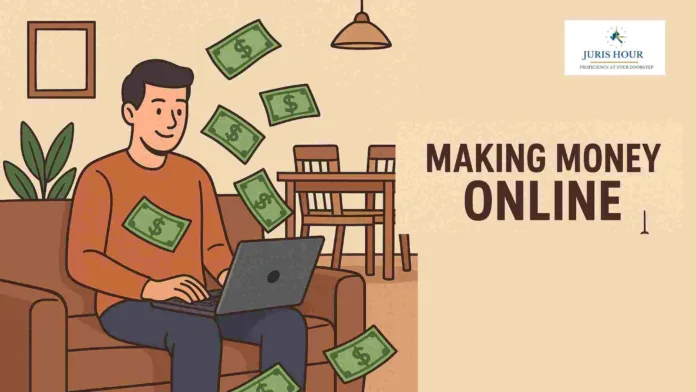There are simple, beginner-friendly ways to earn online—freelancing bite-size projects, selling digital goods, tutoring, content creation with platform monetization, print-on-demand, affiliate links, and paid research tasks. None are “get rich quick,” and most pay only after you meet platform rules and avoid common scams. Below is a practical, news-style guide with fresh facts, fees, and guardrails.
1) Freelance micro-gigs: the fastest on-ramp for skills you already have
If you can write, edit, design simple graphics, transcribe audio, clean up spreadsheets, or do basic video captions, you can pick up paid one-off tasks within days on major marketplaces.
- Why it’s “easy”: Clients post small, clear briefs; you apply with a short pitch and a sample.
- Proof it’s big: Freelancers generated about $1.5 trillion in earnings in 2024, with knowledge work (programming, marketing, IT, consulting) a major slice.
- Make it work: Start with tightly scoped offers (e.g., “proofread 1,000 words,” “design one Instagram post template”) and deliver fast to rack up reviews.
- Watch the fees: Marketplaces take a cut; read their fee pages before you price.
2) Create once, sell many times: digital downloads & online courses
You don’t need to be a YouTuber to sell helpful PDFs, templates, or short courses.
- Digital downloads on Etsy: Listing costs $0.20 per item; listings expire after four months and renew for the same fee. There are additional transaction/processing fees, so price with margin.
- Self-publish eBooks (Amazon KDP): eBooks pay 35% or 70% royalties depending on price/territories; 70% applies typically between $2.99–$9.99 (delivery costs apply). Print royalties and costs vary, with a June 10, 2025update moving certain print royalties to 50% for lower-priced books.
- Courses (hosted): Platforms like Teachable now have a Starter plan that charges a 7.5% transaction fee (plus payment processing ~2.9%+30¢ US) — cheap to start, but fees add up. If you plan volume, compare higher-tier plans or alternatives.
- Marketplace courses: On Udemy, the instructor revenue share on subscription access (Udemy Business) is 17.5% in 2025 (down from 20% in 2024); marketplace revenue share policies differ. Read the fine print before you commit.
Easy starting ideas: budget trackers, Notion/Canva templates, classroom worksheets, niche checklists, one-hour skill primers.
3) Print-on-Demand (POD): merch without inventory
Upload a design; the platform prints and ships when someone orders.
- What to know: POD companies differ on monthly fees and per-sale deductions. For example, Redbubble uses tiered plans with fees based on monthly earnings for most sellers; Printful has free signup with paid plans optional. Price checks matter.
- Why it’s “easy”: No stock, no shipping.
- Reality check: Sales come from your marketing; marketplaces are crowded.
4) Content creation: small channels can monetize sooner, but rules apply
Short-form video, blogs, and newsletters can pay via ads, tips, brand deals, affiliates, and storefronts.
- Macro trend: Forecasts say creator platforms could out-earn traditional media ad revenue in 2025, reflecting a shift in where advertisers spend. That doesn’t mean individual creators get rich—only a small share earn six figures.
- YouTube Partner Program (YPP):
- Full ad revenue sharing requires 1,000 subs + 4,000 public watch hours (12 months) or 1,000 subs + 10M valid Shorts views (90 days).
- A lower-bar YPP path (to access fan funding/shopping tools) exists at 500 subs + 3 public uploads + 3,000 watch hours (12 months) or 3M Shorts views (90 days)—useful for early monetization features.
- Quick win ideas: How-to shorts, local language explainers, template walk-throughs, product comparisons linked with affiliates.
5) Affiliate links: simple to implement, modest per-sale payouts
Recommend products you genuinely use, and earn a cut when readers buy.
- Amazon Associates: Commission rates vary by category (e.g., up to 10% on Luxury Beauty, ~4–5% on books/handmade/music; 0% on some categories). Cookie windows and rules apply; always disclose.
- Why it’s “easy”: No customer support or shipping.
- Reality check: You need traffic (content or social). Use honest reviews to build trust.
6) Online tutoring & teaching: low setup, steady demand
Offer language conversation, school subjects, or test prep.
- Why it’s “easy”: A webcam and a clear curriculum get you started.
- Tip: Start with short, fixed-price packages (e.g., 3 × 30-minute sessions). Use marketplaces to find early students, then build direct referrals to cut platform fees.
7) Paid research & microtasks: simple, but set expectations
- Legit research panels like Prolific enforce a minimum pay of ~$8/hour (US) and recommend $12/hour. It’s one of the fairer options for surveys/experiments.
- Microtasking (e.g., MTurk): Typical reported earnings cluster around $2–$6/hour, with skilled workers sometimes reaching $8–$12—not great as a main income, better as filler time.
Beware of “too easy”: the 2025 scam patterns to avoid
- Work-from-home claims promising “$100K/month” store automation or coaching schemes have faced FTC action; big income promises rarely pan out.
- “Task”/“boosting” scams (often via WhatsApp/Telegram) stole over $220M in H1 2024, per FTC warnings highlighted in the tech press: they pay small amounts up front, then pressure you to “deposit” to unlock bigger payouts. Don’t pay to get paid.
- Golden rules: Never pay for starter kits, training, or “slots.” Use escrowed marketplaces or platform-native payouts. If a job finds you and wants money first, it’s a no.
A simple 30-day starter plan (no prior audience required)
Week 1: Pick one path + one backup (e.g., “Etsy digital template” + “freelance micro-gigs”). Draft 3 tiny offers/products.
Week 2: Publish (Etsy listing with preview images; Upwork/Fiverr gig with a 2–3 sample portfolio). Under-promise, over-deliver.
Week 3: Add one affiliate review post or short video tied to your niche; apply for Amazon Associates after your first few content pieces.
Week 4: Try a Prolific session for quick wins; ship a second digital product; collect testimonials and convert them into images you can reuse in listings.
What “easy” really means in 2025
- You can start with free or low-cost tools and sell within days.
- Platforms are crowded and fee-heavy—but transparent if you read the policies cited above.
- The most reliable money comes from repeatable micro-offers, clear deliverables, and steady publishing, not virality.
If you want, tell me your skills, free time per week, and whether you prefer on-camera or not—I’ll map a custom, step-by-step plan around one path so you’re not juggling too much at once.
Read More: RTI vs PAN: What a Spouse Can—and Can’t—Find Out in a Maintenance Battle

